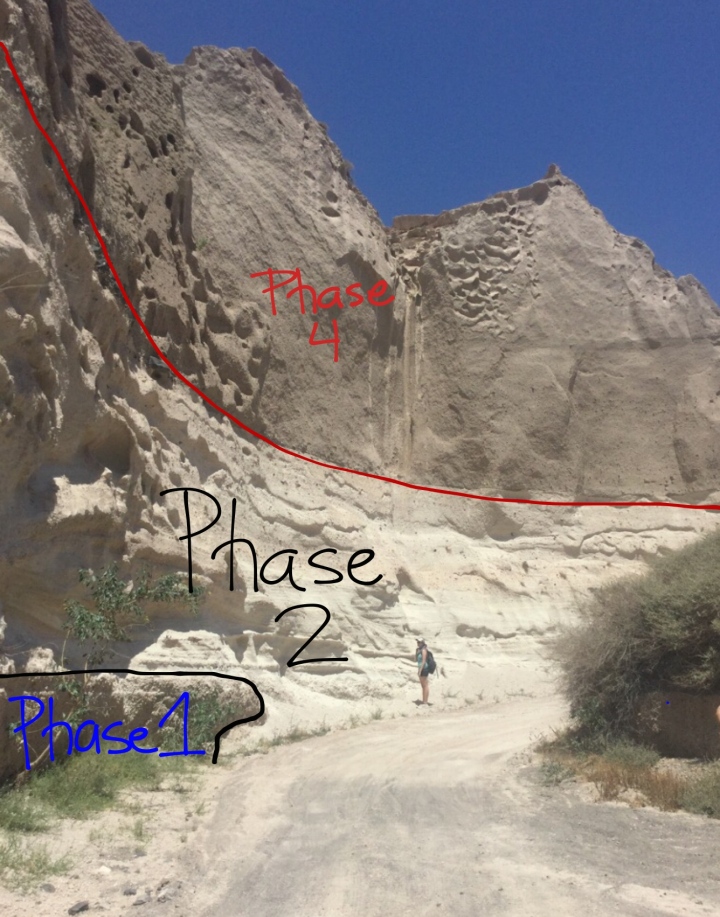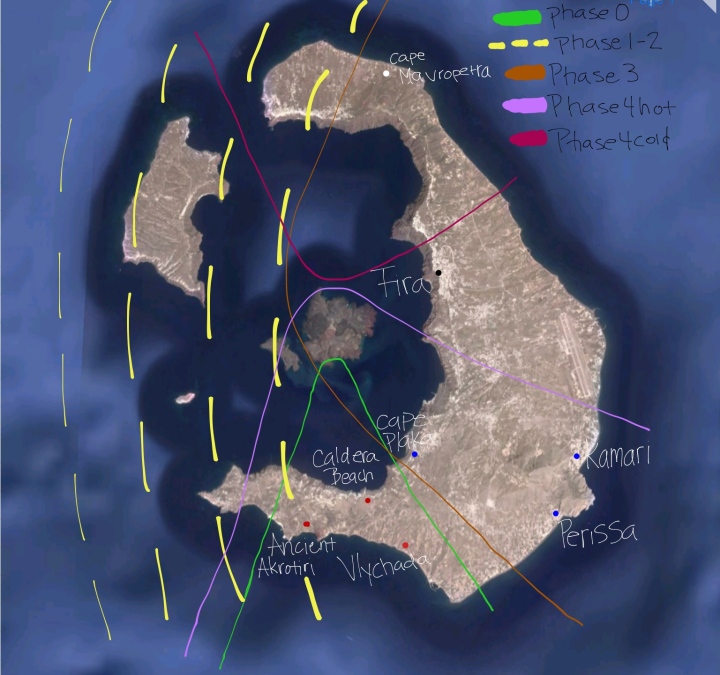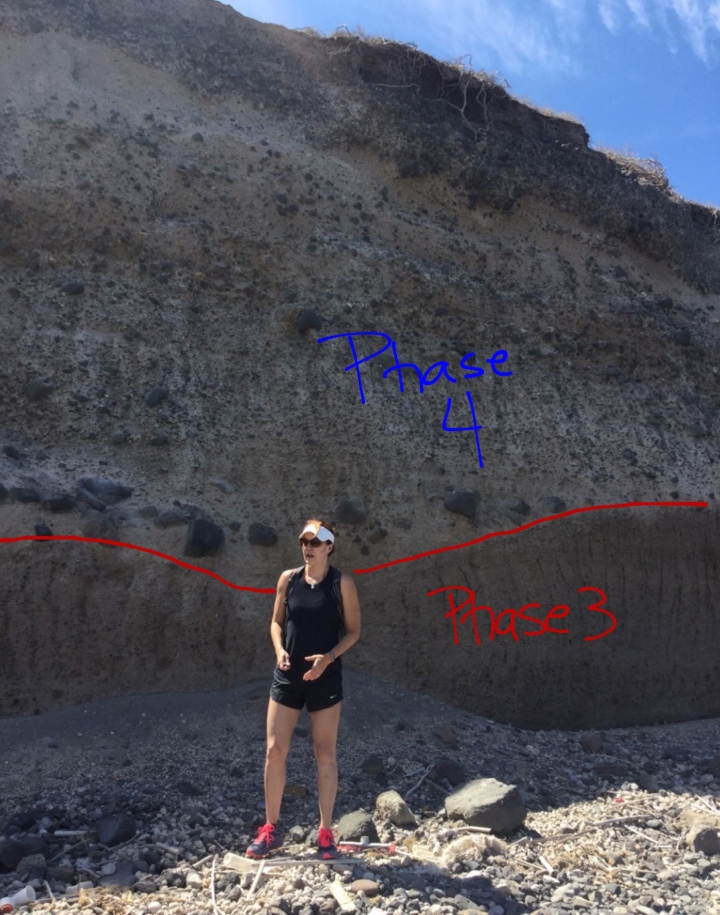When I woke up on Wednesday morning, I was mentally preparing for a grueling day in the hot Santorini sun. Sweating sunscreen into my eyes while frantically scribbling notes every time Lisa spoke was the usual. Nonetheless it was exciting to spend every day in the field learning new things. Today we would be learning how to draw an outcrop sketch, which shows a section of stratigraphy in painstaking detail.
Armed with my field notebook and a positive attitude I was ready to sit for a couple hours and draw, until we got out of the van and immediately got a face full of wind heavy with ash. We spent only 30 minutes of the intended three hours looking at the outcrop because the wind made it impossible to sit and draw. In those 30 minutes though, we learned something new about the stratigraphy of the island.

Figure 1: This pictures was taken at Vlychada and shows how the layers skip from phase 2 to phase 4.
For the past week we had been studying the early stages of the Minoan eruption and learning what they look like as well as how to identify them. We had just started learning about phase three and what it looks like. Which is why I was confused when we got to Vlychada Beach and what was above phase two looked nothing like the phase three we had learned about. Each phase of the eruption creates a new layer that stacks on top of the layer that came before it. Usually above the phase two layer comes phase three, a white layer with lithic fragments. This is not what I found at the beach that day.
Phase four is a darker color than phase three, which is what immediately made me recognize that this was not the same material that was directly above phase two in other places on the island. This is when Lisa explained that phase three is not present in this location on the island, so the stratigraphy skips straight from phase two to phase four. This information caused a lot of confusion for me as I hung back from the group to take pictures and try to figure out what happened to phase three.
Phase three is a lighter color and has a lot of lithic fragments, which are pieces of rock that came from the vent of the volcano that are not ash and pumice. I knew this because I dedicated a large portion of my day earlier that week to drawing a highly detailed stratigraphic column of phase three. The phase four materials that we saw in this area had no lithic fragments and the rock outcrop towered above me. It was at least eight times my size, and I am 5’9” (approximately 1.8 meters) tall. That means this outcrop is about 15 meters tall, that is a huge amount of material to be ejected from a volcano!
Since the weather was not cooperating that and day we had to cut our time at the beach short, I did not have the opportunity to ask questions about why the layering happened this way. I had to ask, why is phase three missing here?
It turns out that the layers of ash, pumice, and rock deposited by the Minoan eruption varied depending on where you are. Some parts of the island look completely different than others even though they are products of the same eruption.

Figure 2: This map shows the boundaries for the deposits of each phase. (Phases 1-2 are getting thicker as the lines move East across the map)
Cataclysmic volcanic eruptions produce many different types of deposits that may or may not cover all of the surrounding landscape. Imagine that you could go back in time and sit on the island to watch the eruption. What you would witness is pure chaos.
Pumice fall is controlled by the wind direction. Enormous amounts of pumice and ash are shot into the sky and then blown around and deposited on the earth like a blanket of snow. During phase two, an observer would see massive swirling clouds of gas carrying pumice and leaving deposits behind as the cloud moved along. Phase one and two cover the entire island in varying thickness, the deposits of ash and pumice get thicker as you travel East on the map because that is the primary wind direction on the island.
Phase three covers a large majority of the island but if you look at the southern tip at Vlychada in figure 2, where I first observed the missing layer, it is beyond the boundary for phase three. What you would witness for phase three is a fast moving cloud of gas carrying pumice ash and lithic fragments. Imagine a gigantic column of ash and pumice extending almost 20 miles into the air. Part of this column collapses and sends a cloud of this material racing across the landscape.
The deposits left behind by phase three only appear in some places because this cloud would carry everything and then drop it all at once, creating a massive deposit. The path of a pyroclastic flow is completely random and can fall anywhere on the island, which is why phase three deposits are not found on the entire island.

Figure 3: This shows a location on the Northern part of the island, Cape Mavropetra, where phase 3 is below phase 4. The rocks of phase 4 here are also different from the phase 4 previously shown.
You could spend every day for three weeks on this island in a different geographic location, drawing the stratigraphy there and comparing it to the surrounding areas and find that it is different everywhere. At first I could not help but wonder why it was necessary to draw stratigraphic columns over and over again when the rocks are going to be the same five miles down the road, but I soon learned that this was not the case. Every area on the island looks different and has unique stratigraphy that is not exactly the same anywhere else.
Imagine what it would look like to be present for this incredible eruption: surges going one way, flows another, all while pumice and ash are falling out of the atmosphere and altering the landscape forever. The different locations and compositions of each deposit help us unfold the mystery of what was happening during the eruption. The sheer size of the deposits and the blocks that were ejected from the vent are examples of the force that was exerted. The fact that they ended up all over the island really starts to put into perspective just how mind-blowingly enormous and violent the Minoan eruption was.

Hi Sam,
Really informative post this week. I enjoyed the detailed analysis of the stratigraphy in different parts of the island. Something I noted as a reader unfamiliar with a lot of the terms you’ve been learning is that a solid definition of each of the phases and some of the geology-oriented vocabulary could help comprehension. It’s really easy to overlook defining vocabulary when you have been using the terms for weeks; a few that I thought would be useful to define were “surge,” “flow,” and the different phases.
I enjoyed the pictures you included, and I think the captions on them are a good opportunity to show something to your audience that is difficult to put into words. For example: figure one’s caption is “This pictures was taken at Vlychada and shows how the layers skip from phase 2 to phase 4” which is true, but it could do a little more work to show exactly what that means. In writing for a blog like this–where the audience is composed of people who don’t know about the different stratigraphic layers–it is helpful to replace the names “Phase 1, phase 2, etc.” with descriptions of those phases. In the caption I mentioned before you could point out the specific composition of each layer then write what that means.
In a few points in the post you introduce ideas that are really interesting, and your audience will want to know more. At one point you say “what you would witness is pure chaos” and pure chaos sounds like something that would be neat to hear described. For future posts when you introduce an idea that you think the audience would want to hear more about, describe it in detail. Always expand on your ideas, and explain them with your audience in mind.
Looking forward to future posts.
Justin
Justin,
Thank you for taking the time to read my blog. I appreciate all the comments and will be sure to consider everything you said when I write my next blog!
Hi Sam – oh the woes of the internet here. This is the third time i have written out my comments here!
I think your introduction is excellent and that you did an excellent job of explaining the concept of volcanic (pyroclastic) stratigraphy here. An explanation of what a phase is would go a long way. Dont forget to include those smaller yet important explanations of geological terms.
Great use of photos and annotations. Keep up the good work!